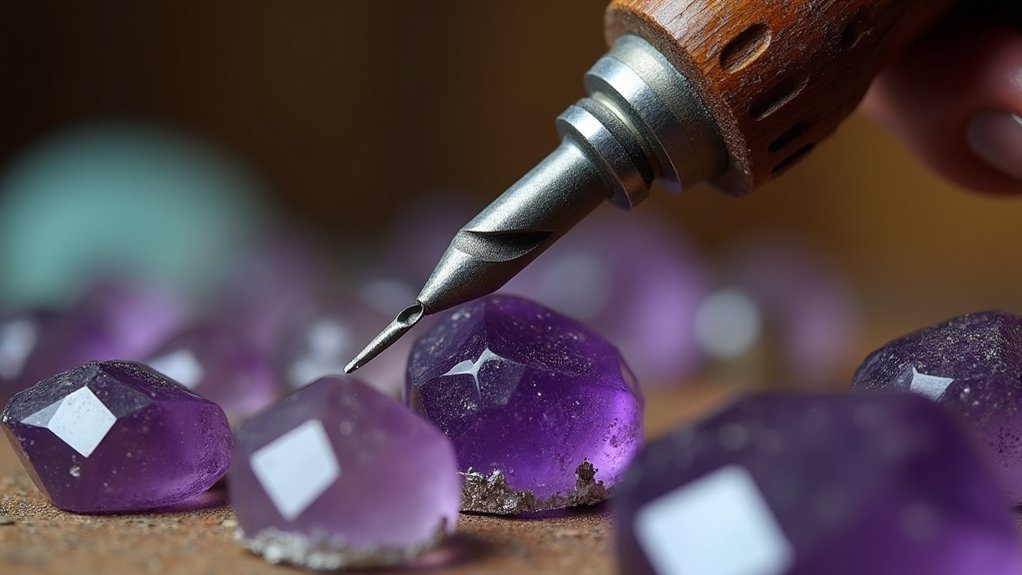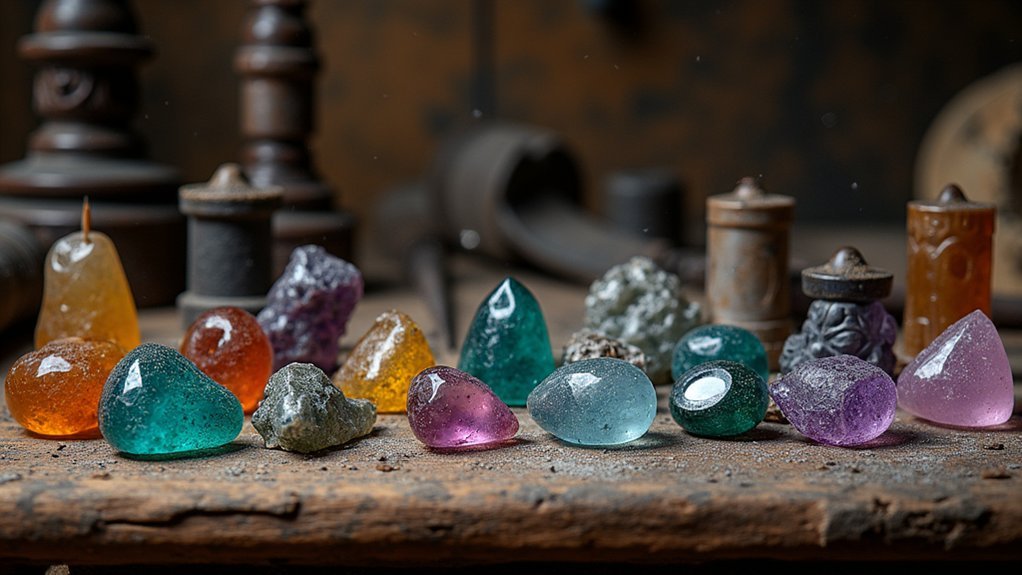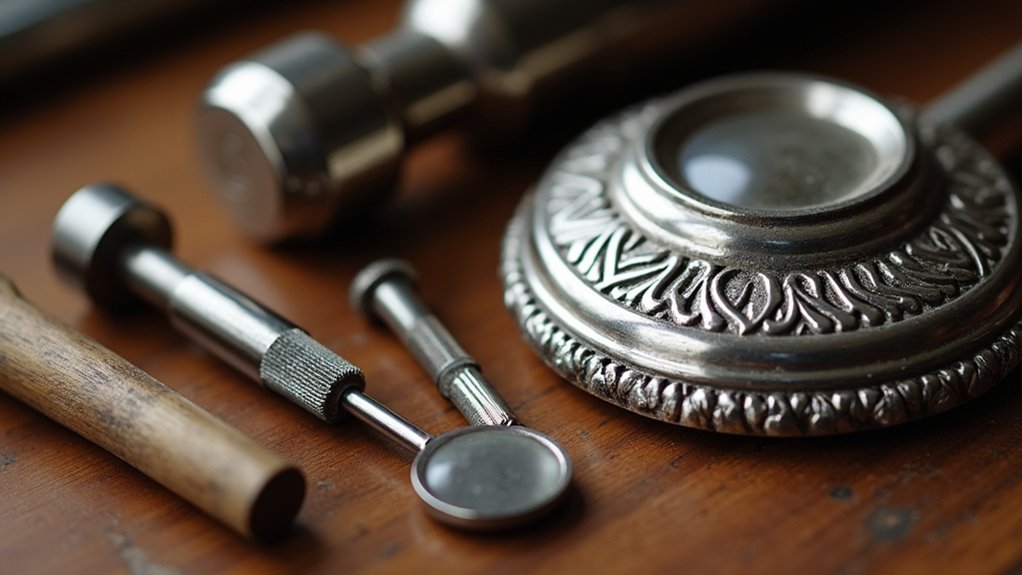You’ll find that ancient craftspeople mastered five remarkable gemstone drilling techniques: stone-on-stone abrasion using harder minerals like quartz to wear away softer stones, bow drill technology that employed friction from rotating spindles, pump drill mechanisms with cord-twisting systems for enhanced precision, hand-powered bronze and iron tools that provided superior durability, and natural abrasive materials like emery and garnet for intricate designs. These methods reveal the sophisticated skills that created stunning jewelry across civilizations.
Stone-on-Stone Abrasion Methods

Among the earliest gemstone drilling techniques, stone-on-stone abrasion methods emerged when ancient craftspeople discovered they could use harder minerals to gradually wear away softer stones.
You’ll find that ancient cultures employed this controlled shaping technique by selecting harder stones like quartz and flint as natural abrasives against precious stones. These skilled lapidaries understood that consistent pressure and patience would yield remarkable results.
When you examine archaeological evidence, you’ll see this grinding process was widespread across Egyptian, Maya, and Mesopotamian civilizations.
They’d rub the harder stones against soft stone surfaces, methodically removing material until achieving their desired shapes.
You can imagine how these abrasion methods required incredible skill, as craftspeople had to maintain steady hand movements while gradually wearing down gemstones into intricate jewelry and functional tools.
Bow Drill Technology and Applications
As ancient craftspeople sought more efficient drilling methods, they developed the revolutionary bow drill technology that would transform gemstone working forever.
Dating back to the Upper Paleolithic Period, this versatile tool technology revolutionized how artisans approached gemstone cutting across ancient cultures.
The bow drill’s drilling process relied on friction generated by rapidly rotating a spindle against the gemstone surface. This innovative mechanism allowed craftspeople to create precise holes efficiently, making it invaluable for both drilling and cutting tasks.
Through controlled friction and rotational force, the bow drill transformed raw gemstones into precisely perforated treasures for ancient artisans.
- Construction materials: Wooden bow frame with sturdy stick spindle, often featuring stone or metal tips
- Operational method: Bowstring mechanism rotated drill bit through back-and-forth motion
- Cultural adoption: Widely used by Native Americans, Egyptians, and other civilizations
- Historical significance: Remained essential until the 20th century, demonstrating remarkable longevity
Pump Drill Mechanisms for Enhanced Efficiency

While bow drill technology marked a significant advancement in gemstone working, the pump drill mechanism represented an even greater leap forward in drilling efficiency and precision.
You’ll find that pump drills, used since Roman times, operate through a clever cord-twisting system around a shaft. When you push down on the horizontal plank, the mechanism continues drilling even after unwinding, maintaining consistent pressure through the weighted disc above the bit.
This enhanced efficiency makes pump drills superior for cutting hard gemstones compared to earlier ancient techniques.
Historical evidence shows you can achieve deeper, cleaner holes with greater precision, elevating your lapidary work quality. The mechanisms allow for intricate craftsmanship details that weren’t possible with traditional hand-powered drilling methods.
Hand-Powered Bronze and Iron Tools
Bronze and iron hand-powered drills revolutionized ancient gemstone working by providing craftsmen with durable, precise tools that could penetrate even the hardest materials.
Bronze and iron drills gave ancient craftsmen the durability and precision needed to work with the hardest gemstones.
You’d find these drilling tools essential in traditional lapidary practices, where artisans couldn’t rely on modern technology. The superior hardness of bronze and iron allowed craftsmen to achieve better drilling efficiency compared to earlier stone implements.
These hand-powered drills worked alongside other important equipment:
- Grinding wheels made from hard stones rotated manually to shape gemstones before drilling
- Fine abrasives like emery enhanced the precision of drilling operations
- Polishing tools with treated leather pads created smooth finishes after drilling
- Specialized drill bits crafted from bronze or iron maintained sharpness longer
You’d see craftsmen combining these tools with abrasives to create reflective surfaces on finished pieces.
Natural Abrasive Materials and Grinding Techniques

The effectiveness of bronze and iron drilling tools depended heavily on the natural abrasive materials that ancient craftsmen paired with them.
Ancient artisans utilized emery, quartz, and garnet to drill and shape precious gemstones, exploiting their hardness for intricate designs. These grinding techniques involved hand-powered drills with bow or pump mechanisms that allowed controlled rotation and penetration.
You’ll find that loose, dry abrasive materials proved ineffective for deep drilling. However, fixed abrasives or those mixed in watery slurries successfully produced concentric cutting lines on hard stones.
Tubular copper drills combined with finely pulverized abrasives enabled precise drilling of materials like granite. This drilling process demanded meticulous attention to detail, as craftsmen balanced functionality with aesthetic appeal in their finished products.
Frequently Asked Questions
How Did They Cut Gems in Ancient Times?
You’d use bow drills with copper or iron bits, applying abrasives like quartz sand for drilling holes. You’d employ cabochon techniques for smooth, rounded cuts, relying on hand-powered tools and manual labor.
How Do You Drill a Hole in Precious Stone?
You’ll use a bow drill with tubular copper bits, applying abrasive sand or emery powder mixed with water. Rotate consistently while maintaining steady pressure to gradually penetrate the stone’s surface.
How Did Romans Cut Gems?
You’d use hand-powered bronze or iron drills with bow mechanisms to cut gems. You’d create cabochons for smooth surfaces, cameos for raised designs, and intaglios for recessed images using emery abrasives.
What Is the Difference Between Lapidary and Gem Cutting?
You’ll find lapidary encompasses all stoneworking techniques including tumbling and cabochon cutting, while gem cutting specifically focuses on faceting precious stones like diamonds to maximize their brilliance and value.
In Summary
You’ve discovered that ancient craftspeople weren’t limited by modern technology when creating stunning gemstone jewelry. You can appreciate how they mastered stone-on-stone abrasion, bow drills, pump mechanisms, bronze tools, and natural abrasives to achieve remarkable precision. These time-tested techniques prove that skill, patience, and ingenuity can overcome any technological limitations. Whether you’re a jeweler, historian, or craftsperson, you’ll find inspiration in these enduring methods that shaped civilization’s most treasured artifacts.





Leave a Reply